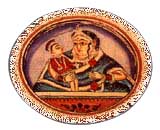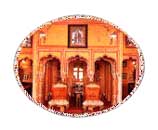|
The
area of Shekhawati covers several villages and towns
in north eastern Rajasthan, which can be approached
from Bikaner, Jaipur and Delhi and comprises the Sikar
and Jhunjhunu districts. Small towns dot these two
districts and contain within themselves some of the
most elaborate havelis, stepwells and temples.
|

The
Platter Painting
|
|
When you travel around this region,you stumble
across some truly marvelous treasures. Even
Today the entire region of Shekhawati is known
for its exquisite frescoes and popularly called
the open art gallery . No other region, anywhere
in the world has such a large concentration
of frescoes. This is even more interesting as
the landscape here is totally bare flat and
colourless. Rao Dhekha the founder of Shekhawti,
came to power at the young age of 12 and established
a reign that listed 43 years.
|
|
|

Dundlod
Castle
|
His
power grew steadily and he became a force to reckon
with in a very short period. The Rajput nobles who
ruled over the small thikanas or fiefdoms, became
great patrons of art and financed the frescoes on
their havelies. up to the early 19th century the themes
were largely religious.
|
|
Other
historical events personages, battle scenes
and folk heroes were also painted in great detail.
These paintings were a record of those times.
By the end of the 19th century there was a slight
change in the patronage. The business community,
Marwaris found itself in a position of strength.
When the East India company began to make its
presence felt in this part of Rajasthan, It
opened several avenues for the hardworking and
enterprising Marwari. The volume of Trade increased
and the Marwaris began to spread their branches
all over the country. Even after spending several
years away from their homeland these now successful
and wealthy businessmen remained true sons of
the soil. While they lived austerly in their
adopted cities they sent back huge sums of money
to their families.
|
|
They
spent large sums on the welfare of their community wells,
reservoirs schools, colleges,Dharamshalas and aushalas were
financed. Most of them had left their families behind and
they returned to build some huge mansions for them. They
were in a position to show off their new status and there
was no better way of doing this than commissiong the most
intricate frescoes on their havelies.
|

